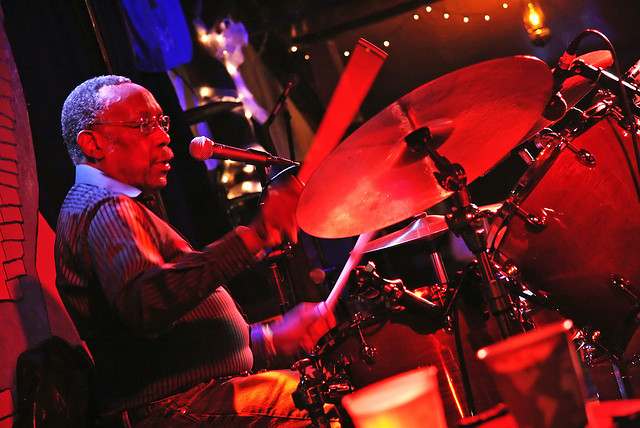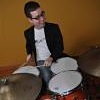Home » Jazz Articles » Interview » Clyde Stubblefield: Samples of Funk
Clyde Stubblefield: Samples of Funk

James Brown was a fabulous musician and entertainer, but he wasn’t anything without the band.
—Clyde Stubblefield
Originally from Chattanooga, TN, Stubblefield is most famous for his work with James Brown. Alongside fellow drummer John "Jabo" Starks, Clyde Stubblefield was responsible for the legendary beats that shaped classic James Brown tunes including "Cold Sweat," "Say It Loud," "I Feel Good," and "Funky Drummer." These "sampled" beats have been re-purposed into hits for a variety of artists such as Prince, The Beastie Boys, N.W.A., LL Cool J, Sinead O'Connor, and even Kenny G. However, due to lax enforcement of recording ownership laws, virtually no royalties from these mega-hits have found their way into the hands of the musicians who actually created the music. We sat down with Clyde after a masterclass and performance at The Tonic Room in Chicago to discuss his work with James Brown, jazz influences, gear-setups, and recovery from a hand injury that left him unable to perform for years.
All About Jazz: You've recorded half a dozen live albums at The Apollo. What's it like performing for that crowd? What kind of energy do you sense from that room?
Clyde Stubblefield: Marvelous and dy-no-mite. We always go to knock people out. That was our gig and I loved it. Every song was fantastic and the audience was fantastic.
AAJ: People say that James Brown was a genius because of his sense of rhythm and timing. Your contributions to his music have been slow to gain recognition, how do you feel about the fact that a lot of these songs' recognizability hinged on the drum breaks and the rhythm section grooves?
CS: Well James Brown was a fabulous musician and entertainer, but he wasn't anything without the band. We had a good time playing behind him.
AAJ: Basically what I'm saying is I attribute a lot of that rhythm to you as opposed to James Brown. Michael Tilson Thomas (concert pianist) had some association with James Brown, declared Brown "a genius because of his rhythm," but you were the rhythm behind the band.
CS: Well, I appreciate you thinking that I was the one—you're right about the band's rhythm, 100% right—but I appreciate your noticing [my contribution to the music]. What I mean, he would have been hot, but he wouldn't have been as hot as he was [without us]. But I never got that acknowledgment.
AAJ: And you feel like it's been a long time coming too, right?
CS: Oh, yeah, absolutely.
AAJ: On the James Brown recordings with John Jabo Starks, you tended to keep things very much inside the pocket, right?
CS: Right.
AAJ: I spent a long time watching old videos of you performing with James Brown. On many of the live drum breaks, your style seems to morph into a very be-bop, almost Tony Williams kind of sound. In the sixties or early eighties, your setup was much like Max's or Elvin's. What kind of influence did the be-bop and the post bop sound have on your funk drumming?
CS: I made my own tunes, the audience was my only influence. That's the way it all worked with me. I had no special thing outside of the audience.
AAJ: You played on my drum set tonight—I hope you enjoyed playing some of those grooves on an 18" bass drum.
CS: I loved it. I didn't know it was a Yamaha kit.
AAJ: Those grooves sounded really nice on a be-bop kit. What kind of set up are you currently using in the studio?
CS: I use whatever they have, but I request Yamaha.
AAJ: How'd you get hooked up performing on Michael Feldman's radio show?
CS: "Whad'ya Know?"
AAJ: Yeah,
CS: I used to do that show, I'm out of it now. I have one more show in April, and that's the end of me doing it. And they'll be closing that show down in about a month or so after that.
AAJ: "Whad'ya Know," with Michael Feldman. I didn't know it was going off the air.
CS: It was a great show—was on Saturday mornings.
AAJ: Any projects in the future? Recordings, clinics, tours?
CS: No, just conversations, going to auditoriums, talking to people, rappin,' letting them know what's going down.
AAJ: Great—and then, just a side note, sorry to speak of this, but you had an injury, to your hand.
CS: Yeah, lost my thumb.
AAJ: How are you adjusting to that?
CS: Well it's giving me new ideas, new patterns, and I'm adjusting to it well.
Tags
Clyde Stubblefield
Interview
Ben Scholz
Benjamin Scholz Productions
Los Angeles
Chattanooga
James Brown
Kenny G
The Tonic Room
Chicago
Tony Williams
PREVIOUS / NEXT
Support All About Jazz
 All About Jazz has been a pillar of jazz since 1995, championing it as an art form and, more importantly, supporting the musicians who make it. Our enduring commitment has made "AAJ" one of the most culturally important websites of its kind, read by hundreds of thousands of fans, musicians and industry figures every month.
All About Jazz has been a pillar of jazz since 1995, championing it as an art form and, more importantly, supporting the musicians who make it. Our enduring commitment has made "AAJ" one of the most culturally important websites of its kind, read by hundreds of thousands of fans, musicians and industry figures every month.






















